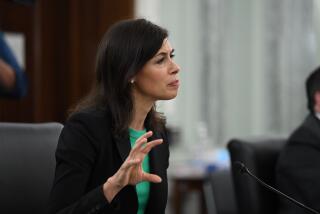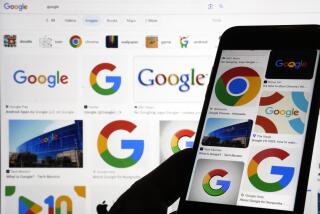TV Spectrum to Be Opened for Other Uses
WASHINGTON — The Federal Communications Commission on Thursday struck a compromise that would give technology companies some access to the white space between television channels while addressing broadcasters’ fears that new gadgets could interfere with their signals.
Under pressure from Congress, the FCC took the first step toward allowing fixed wireless devices, such as broadband receivers in homes, to use most of the vacant channels in any given market after the digital TV transition in February 2009.
Those vacant channels -- ranging from about a third of the spectrum in big cities such as Los Angeles to three-fourths in rural areas -- are reserved almost exclusively for TV broadcasters. But high-tech executives covet them for devices that could offer wireless services such as more powerful municipal broadband networks and video streaming from a computer to a TV.
The FCC deferred decisions on two major issues.
It still must determine whether mobile devices also would be allowed to transmit on the white spaces, which vary from market to market and would require sensing technology to avoid interference.
And commissioners must decide whether to auction off the vacant spectrum for licensed use, as it does with cellphone bands, or allow free, unlicensed use, as is done with Wi-Fi and existing low-range devices such as baby monitors and garage door openers.
“At least they’re taking a cautious approach,” David Donovan, president of the Assn. for Maximum Service Television, said of the FCC. His association is the technical and engineering trade group of TV broadcasters.
“People have to understand what’s at stake here: undermining billions of dollars in investment in new digital receivers which consumers will have to make over the next couple of years,” he said.
Interference with digital TV signals is harder for viewers to detect, Donovan said. Instead of causing static, as it does with analog signals, interference causes digital broadcasts to lose sound, freeze or break up, also signs of trouble with the TV, receiver or station.
Representatives from Microsoft Corp. and Dell Inc., two of the leading supporters of opening up the white spaces, said they were confident they could show the FCC that technology could be developed to avoid interference. The TV spectrum is ideal for wireless devices because it penetrates walls and other obstacles and can carry large amounts of data.
“There’s just so many possibilities out there,” Kerry Murray, Dell’s senior counsel for international public policy and government relations, said of the potential uses for new devices. “We’ve got a date. Let’s move the process forward and let’s finish it.”
But the FCC is taking a go-slow approach. It will do extensive testing of new devices to ensure that they won’t cause interference before considering a final plan next fall. FCC Chairman Kevin J. Martin, a Republican, said his “first priority is to further the digital transition.”
Martin did not say whether he supported allowing free use of the spectrum by unlicensed devices. But the commission’s two Democrats, Michael J. Copps and Jonathan S. Adelstein, argued strongly for it.
Copps noted the success of unlicensed Wi-Fi devices and said the government should allow free use of the white spaces to balance the recent auction of large amounts of licensed spectrum to wireless phone and data providers.
A major telecommunications bill pending in the U.S. Senate calls for the vacant white space spectrum to be opened to unlicensed devices and directs the FCC to develop rules for use of the spectrum within 270 days of the bill’s passage. The pressure forced the FCC to act, said J.H. Snider, research director for the Wireless Future Program at the New America Foundation, a nonpartisan think tank.
More to Read
Inside the business of entertainment
The Wide Shot brings you news, analysis and insights on everything from streaming wars to production — and what it all means for the future.
You may occasionally receive promotional content from the Los Angeles Times.











